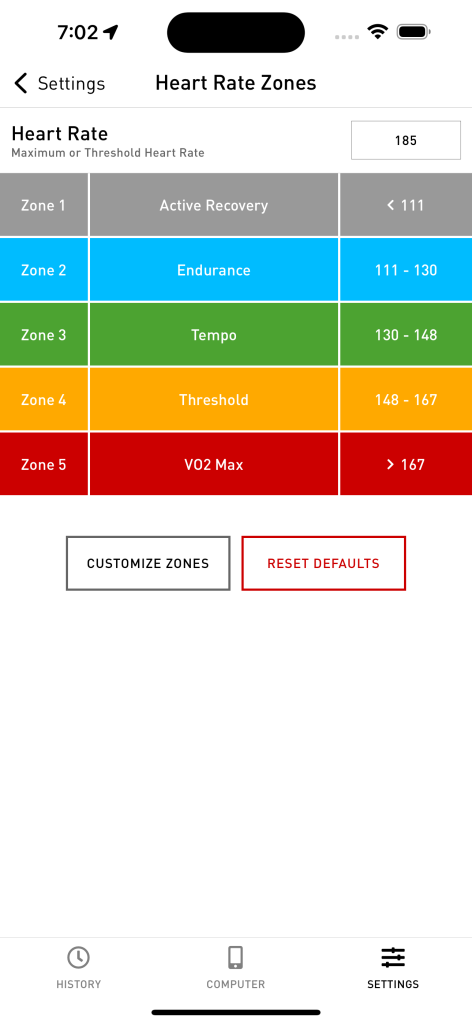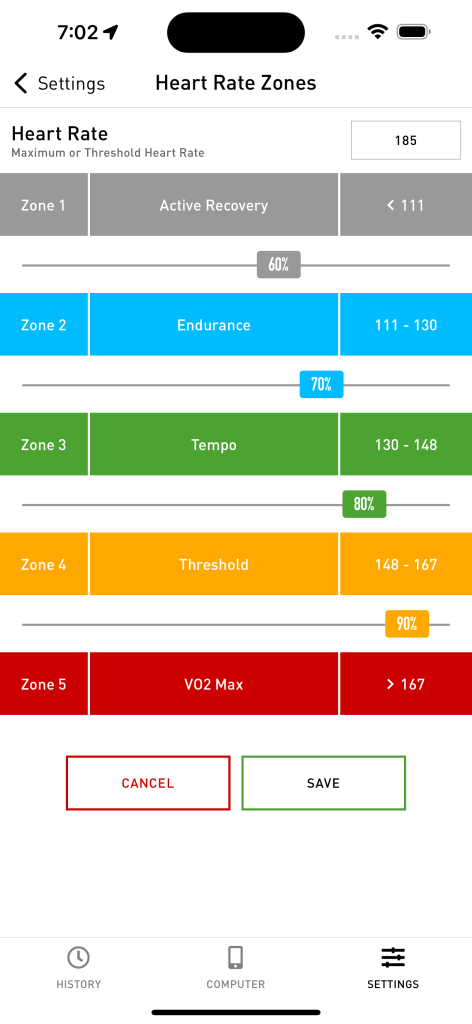If you’re looking for a new way to train, heart rate zone training is the way to go! Not only will it help you improve your performance, but it will also reduce the risk of burnout and overtraining.
Let’s take a deeper look at what heart rate zone training is and how to implement it in your exercise routine.
What to Know About Heart Rate
Your resting heart rate is the number of times your heart beats per minute while at rest. We will be focusing on your resting heart rate, your maximum heart rate, and your recovery heart rate time when learning how to use heart rate zones in your training plan.
A normal resting heart rate for adults ranges from 60 to 100 beats per minute. A lower heart rate means your heart doesn’t have to work as hard and can pump more blood with every beat. That is why athletes often have a lower resting heart rate – their hearts don’t need to beat as often to provide adequate blood and oxygen to the body.
Your HR max (maximum heart rate) is simply the highest number of times your heart can beat in one minute and still keep you alive. A higher HR max typically means you won’t get tired as quickly when exercising, and that’s why most people like to have a high HR max.
Your recovery heart rate time is the amount of time it takes for your heart to return from peak beating levels to its resting rate. The faster it recovers, the more efficient your heart is. Overtime, as you use your heart rate zones to train, this time should become shorter and shorter.
How to Calculate Your Maximum Heart Rate (HR max)?
Before even getting into what the specific heart rate zones are, you have to know your maximum heart rate. Because HR max is different for everyone, here are three ways to calculate it.
Age
A commonly used formula to calculate your heart rate by age is subtracting your age from 220. So if you’re 32 years old, your heart rate is 220 minus 32, which equals 188 beats per minute. However, this has become a bit outdated. A better way to calculate this is 208-0.7 x your age. Using the same example, for a 32 year old, it would be 208 – 0.7(32)=185 beats per minute.
Age is the worst way to calculate this however. Factors such as pregnancy, genetics, and overall health status plays a huge role in determining your max HR.
Stress Test in a Lab
The best way to find HR max is in a lab. Your cardiologist can use very accurate equipment to figure this out. Many universities need participants for studies that include taking a stress test if you’re looking for a free way to do this.
Field Experiment
The most accessible way to figure this out is by doing an experiment on yourself. For this, you simply need a smart watch, or really anything that can track your heart rate (many treadmills have heart rate tracking technology). To figure out your max heart rate, sprint as fast as you can as long as you can. For most people, sprinting at their true max capacity will only allow them to run for 60-90 seconds. Then, see what your heart rate is. This should be your HR max.
How Should Heart Rate Influence Your Training?
In order to achieve maximum efficiency, your training plan should take into account your heart rate training zones, which are calculated in relation to your HR max.
When you’re exercising, your body goes through a few different phases of physical activity. There’s the warming-up and cooling-down phases, and then there are two different intensities of exercise: moderate, and vigorous (light exercise could be included, but would just be an extended warm-up). The intensity of your exercise can have an effect on whether or not your body will be able to complete the workout without becoming overly fatigued or stressed.
In order to find out which intensity is right for you, you need to know what your heart rate is when you’re doing each type of exercise. First we’ll take a look at the warm-up and cool-down phases of exercise.
The warm-up phase should be done before every workout. It helps prepare your body for the more intense activity ahead by raising your heart rate gradually from resting levels until it reaches about 50-55% of its maximum capacity.
The cool-down phase should be completed after every workout. This helps prepare your body for recovery. If you go from intense exercise to laying down, prepare to be extremely sore the next day. You should stay at 50-55% of your max heart rate for 5-10 minutes at the end of your workout.
The two different intensities of exercise, moderate and vigorous, are determined by the following:
- Moderate intensity: 55%-70% of HR max
- Vigorous intensity: 70%-85% of HR max
If you’re a beginner, work towards staying in the moderate intensity zone for 30 minutes consecutively before moving on to vigorous intensity.
Another common way to train is using a multi-zone approach. In this approach there are five zones to be aware of:
- Zone 1: 50-60% of HR max
- Zone 2: 60-70% of HR max
- Zone 3: 70-80% of HR max
- Zone 4: 80-90% of HR max
- Zone 5: 90% and above HR max
How to Create a Heart Rate Zone Training Plan?
The typical endurance training plan uses multiple training zones to push you to improve your fitness. In most plans, the time you spend in each zone varies. You’ll spend the most time in zones near your resting heart rate and the least time in zones near your maximum heart rate. Here’s an example of how a training plan might allocate your time spent in each zone:
- Zone 1: 30%-40% of your time
- Zone 2: 40%-50% of your time
- Zone 3: 10%-15% of your time
- Zone 4: 5%-10% of your time
- Zone 5: 5% of your time
If you are a runner with an HR max of 200 and run for 30 minutes, this is how you could split it up your run:
- 5 minute warm-up aiming for an average HR of 120 (Z1)
- 6 minutes running with an average HR of 140 (Z2)
- 2 minutes running with average HR of 160 (Z3)
- 1 minute running with average HR of 170 (Z4)
- 1 minute running with average HR of 180 (Z5)
- 6 minutes running with an average HR of 140 (Z2)
- 2 minutes running with average HR of 160 (Z3)
- 1 minute running with average HR of 170 (Z4)
- 1 minute running with average HR of 180 (Z5)
- 5 minute cool-down with an average HR of 120 (Z1)
The way you allocate your time will be completely dependent on your personal goals. There are plenty of different training plans out there for training for races, weightlifting competitions, triathlons, and more.
How to Setup Heart Rates Zones in Apps
Apps like Cadence allow you to setup your heart rate zones and display various zone metrics during your workout. Cadence automatically sets your heart rate zones based on your max heart rate, or you can create entirely custom zones to fit your needs.
Once set, you can view your current zone during an activity and see how much time you spent in each zone at the end of your ride or run. You can even setup Voice Announcements to speak your current, split, or average heart at specified intervals.



Download Cadence on iPhone or Android!



